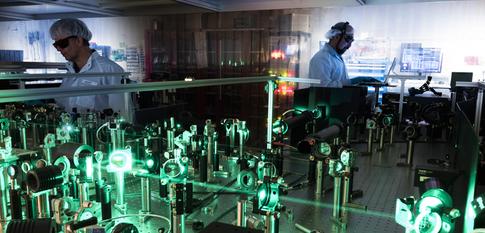XFEL: Versatile optical laser will enable innovative experiments with atomic-scale measurements
https://www.xfel.eu/e35178/e35455/e35456
https://www.xfel.eu/news_and_events/news/index_eng.html
news
news
news
eng
1
1
10
both
0
1
%Y/%m/%d
Press-Release
eng,ger
 To make these measurements, the research team developed a high-power, pulsed, optical laser that is synchronized with the European XFEL pulses and tuneable in both wavelength and pulse duration to the needs of each of the six different experiments. The optical laser pulses activate a process in the samples, before the X-ray pulse is used to probe and investigate the unknown dynamics. It is mainly the “pump” part of these pump–probe experiments the optical laser is designed to perform.
To make these measurements, the research team developed a high-power, pulsed, optical laser that is synchronized with the European XFEL pulses and tuneable in both wavelength and pulse duration to the needs of each of the six different experiments. The optical laser pulses activate a process in the samples, before the X-ray pulse is used to probe and investigate the unknown dynamics. It is mainly the “pump” part of these pump–probe experiments the optical laser is designed to perform.
The features of the optical laser system have been published in the journal Optics Express.
“Our laser is unique because it matches the burst emission pattern of the European XFEL”, said Max J. Lederer, who leads the European XFEL’s Optical Lasers group. “It therefore enables experiments at the highest possible pulse rate of the X-ray laser, with optical pulse parameters such as energy and pulse duration otherwise only observable at low repetition rates from titanium–sapphire systems.”
The pump laser can be tuned for each of the six scientific instruments, which investigate various sample types and phases of matter. The optical laser provides this configurability using a number of optical techniques that harness light–matter interactions to result in the precise energy and timing of the pulses needed.
Currently, the main components of this laser system are being installed for the first two instruments to go into service for users, FXE and SPB/SFX. In November, the Optical Lasers group installed the heart of the first laser system: a set of amplifiers that will set the laser’s frequency and intensity, developed with private industrial partners for the European XFEL.
Lederer and his team look ahead to the exciting capabilities of the system. “We are looking forward to delivering the ‘first photon’ together with the European XFEL”, he said. “Personally, I’m keen on seeing our laser utilized in as many scientific discoveries as possible.”
2016/12/19
Back
Versatile optical laser will enable innovative experiments with atomic-scale measurements
European XFEL team developed optical laser for synchronous operation at six scientific instruments
The European XFEL will provide pulses of X-ray light short enough, bright enough, and of small enough wavelengths to observe processes that would otherwise be too fast to measure in real time.

Max Lederer (l) with colleague Mikhail Pergament in one of the European XFEL optical laser laboratories.
The features of the optical laser system have been published in the journal Optics Express.
“Our laser is unique because it matches the burst emission pattern of the European XFEL”, said Max J. Lederer, who leads the European XFEL’s Optical Lasers group. “It therefore enables experiments at the highest possible pulse rate of the X-ray laser, with optical pulse parameters such as energy and pulse duration otherwise only observable at low repetition rates from titanium–sapphire systems.”
While finding an optical laser capable of producing ultrashort pulses for research, such as a titanium–sapphire (Ti:sapph) laser, isn't difficult, building one that can match the power and timing specifications of the six European XFEL experiments is. “It's the high repetition rate and average power during the bursts that make the difference,” Lederer said.
The pump laser can be tuned for each of the six scientific instruments, which investigate various sample types and phases of matter. The optical laser provides this configurability using a number of optical techniques that harness light–matter interactions to result in the precise energy and timing of the pulses needed.
Currently, the main components of this laser system are being installed for the first two instruments to go into service for users, FXE and SPB/SFX. In November, the Optical Lasers group installed the heart of the first laser system: a set of amplifiers that will set the laser’s frequency and intensity, developed with private industrial partners for the European XFEL.
Lederer and his team look ahead to the exciting capabilities of the system. “We are looking forward to delivering the ‘first photon’ together with the European XFEL”, he said. “Personally, I’m keen on seeing our laser utilized in as many scientific discoveries as possible.”
This article is adapted from a release by The Optical Society, publishers of Optics Express.

